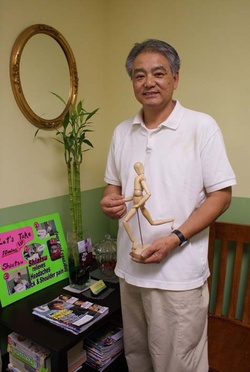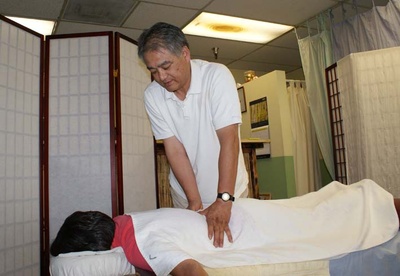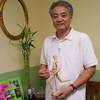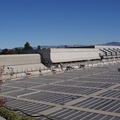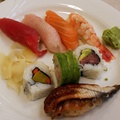When I came to America, I was surprised to find that things that are popular among ordinary Americans are sushi, karaoke, Kurosawa, Hello Kitty... and one more thing: seating. Tsuyoshi Metoki, who runs "EZ Shiatsu & Massage" in Little Tokyo, started working as a shiatsu therapist in America in 1981. This was a time when most Americans were not yet aware of the comfort of having acupressure applied to their bodies.
When she first started working in the U.S., the majority of her customers were American. "The customers didn't like it. They said they didn't like it because I pressed too hard. I had a lot of customers like that. I realized that shiatsu couldn't be used here."
While attending school for shiatsu therapists in Japan and working as an intern at a clinic, Metoki learned that one of his clients, the president of a real estate business, was investing in hot springs in the US. He wanted to bring a Japanese shiatsu therapist there. Having always loved America and heard that it was easy to obtain a visa to emigrate there, Metoki, who was studying shiatsu, was an opportunity that he immediately jumped at.
In the early 1980s, when Japan was still enjoying a booming economy, Metoki started working at Rabida Onsen in the City of Brea (Orange County), a place the president had invested in. In Japan, most customers who come to receive shiatsu have physical problems such as stiff shoulders or back pain, but at Rabida Onsen it was completely different.
"It was a Swedish massage place. It's a relaxing massage. After taking a bath in the hot spring, the customer lies naked on the (massage) bed, and oil is applied all over the body and massaged."
Aromatherapy is also a type of Swedish massage. It has a healing effect. Of course, Meji had no experience with Swedish massage, so he went to a Swedish massage school after work.
"I didn't like it and thought that's not what I came here to do. When I thought the customer had fallen asleep, I started pushing their bodies. I came from Japan to get shiatsu, so I wanted to experience it as much as I could."
Even back then, there were several shiatsu massage parlors run by Japanese people, such as the current Japan Shiatsu Center in Downey, Japan Health Spa in Gardena, and Sanwa Health Spa. However, Americans still shivered at the idea of shiatsu, which involves pressing acupressure points.
After moving from Rabida Onsen to the Japanese-run Tawa Spa in Little Tokyo, where he was busy every day as a shiatsu massage therapist, a major incident occurred that dealt a huge blow to the massage industry: the death of American actor Rock Hudson from AIDS in 1985.
"After Rock Hudson died, AIDS became well-known. Massage parlors became deserted because people said AIDS was contagious."
Massages are usually given after a bath (spa). There was a rumor that if you bathed in the same bath as an AIDS patient, you could catch AIDS. Of course, this was a lie. We now know that AIDS is transmitted sexually and through blood.
"The information about the circumstances under which AIDS was transmitted was completely unreliable. Our industry was in a really difficult situation. At that time, only Japanese people came to spas."
Eventually, the misunderstanding about AIDS was cleared up and visitors gradually began to return, at which point Japan's yen appreciation boom occurred from the mid-1980s to 1990. Although it would be unthinkable now, Japanese tourists flocked to Little Tokyo.
"Tourists and businessmen from Japan flocked to Los Angeles. Baths and massages became popular. Japanese people don't want to get massages from Americans. I think that was the best time."
After leaving Tower Spa, he made a living as a temporary shiatsu massage therapist, but now he and his friends run "EZ Shiatsu & Massage" in Little Tokyo. Having contributed to the spread of shiatsu in Little Tokyo since the 1980s, he responded to requests from customers who wanted him to open a shop in Little Tokyo. The reason for this is that the majority of shiatsu massage therapists in Little Tokyo are non-Japanese (Chinese and Korean).
"Now is the toughest time," says Metoki, but in the midst of this economic downturn, he is handing out coupons, offering senior discounts, and working hard to attract customers through his longstanding relationships with the Japanese community. Recently, American government employees have also come from city hall near Little Tokyo to receive Metoki's shiatsu massage.
"The points that everyone wants me to work on are pretty much set. Shoulders, neck, lower back, probably in that order. I know which points to press because they become stiff when they are stiff. I explain to my clients that 'stiffness' means that their circulation is poor. If you continue to sit in front of a computer for a long time, the strain is put on your muscles and your circulation is impaired, causing stiffness."
According to Metoki, this blood circulation disorder can sometimes cause sleeplessness (light sleep). He says that if you can alleviate it to a certain extent with acupressure massage, you will be able to sleep. "Once you are able to sleep, your physical condition will improve. So if you can't sleep, it's probably a sign that your body is getting stiff."
One of the miraculous cases that Metoki performed involved an 80-year-old man living in Little Tokyo who had fallen and hit his hip so hard that he could no longer walk. He had tried various treatments, including chiropractic and acupuncture, but his condition had not improved at all. His final hope was Metoki's shiatsu massage.
"He came to my house and asked, 'Will it get better?' and I said, 'Yes, it will get better.' Because of his age, I couldn't push as hard as a normal person, but I gave him the same treatment as someone with a normal bad back. I was careful to push in a way that didn't cause him any discomfort. I came once a week, and after a month he was able to stand." He now uses a walker and comes to Metoki's shop by himself.
I myself have experienced Metoki's miraculous treatment. A few years ago, I hurt my hip joint while exercising and was dragging my leg, so I went to receive a shiatsu massage from Metoki. "I'm glad you came. When I got older, I would have been unable to walk," he told me, and after an hour of thorough treatment, lo and behold, I was able to walk easily again. If I had continued like that, my whole body would have become distorted, so I'm really glad I went.
"It's nice when customers tell me that their experience has been more comfortable. I'm happy when they tell me that their experience has been more comfortable every time they come. I think that's what makes it fun to do my job." (Metoki)
* * * * *
EZ Shiatsu & Massage
400 East 2nd Street, #205
Los Angeles, CA 90012
(Inside Honda Plaza Mall)
(213) 680-4970
© 2010 Yumiko Hashimoto


